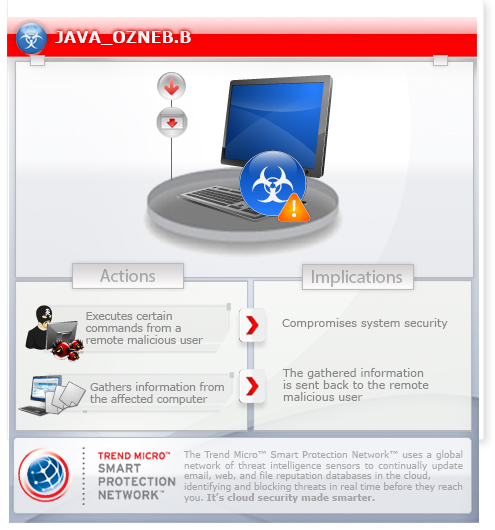JAVA_OZNEB.B
Could be a Trojan horse Java/ClassLoader (AVG) ,a variant of Java/Adwind.G trojan, a variant of Java/Adwind.G trojan (Eset)
Windows 2000, Windows Server 2003, Windows XP (32-bit, 64-bit), Windows Vista (32-bit, 64-bit), Windows 7 (32-bit, 64-bit), Linux, Mac OS, Android


Threat Type: Backdoor
Destructiveness: No
Encrypted: Yes
In the wild: Yes
OVERVIEW
This old remote access Trojan (RAT) can be found as attachments to spammed messages related to financial matters.
To get a one-glance comprehensive view of the behavior of this Backdoor, refer to the Threat Diagram shown below.

This backdoor arrives on a system as a file dropped by other malware or as a file downloaded unknowingly by users when visiting malicious sites.
It executes commands from a remote malicious user, effectively compromising the affected system. It connects to a website to send and receive information.
It gathers certain information on the affected computer.
TECHNICAL DETAILS
Arrival Details
This backdoor arrives on a system as a file dropped by other malware or as a file downloaded unknowingly by users when visiting malicious sites.
Installation
This backdoor drops the following files:
- %Application Data%\oracle\Desktop.ini
(Note: %Application Data% is the current user's Application Data folder, which is usually C:\Documents and Settings\{user name}\Application Data on Windows 2000, XP, and Server 2003, or C:\Users\{user name}\AppData\Roaming on Windows Vista and 7.)
It drops the following copies of itself into the affected system:
- %Application Data%\oracle\olo.dll
(Note: %Application Data% is the current user's Application Data folder, which is usually C:\Documents and Settings\{user name}\Application Data on Windows 2000, XP, and Server 2003, or C:\Users\{user name}\AppData\Roaming on Windows Vista and 7.)
It creates the following folders:
- %Application Data%\oracle
(Note: %Application Data% is the current user's Application Data folder, which is usually C:\Documents and Settings\{user name}\Application Data on Windows 2000, XP, and Server 2003, or C:\Users\{user name}\AppData\Roaming on Windows Vista and 7.)
Autostart Technique
This backdoor adds the following registry entries to enable its automatic execution at every system startup:
HKEY_CURRENT_USER\Software\Microsoft\
Windows\CurrentVersion\Run
oracle = "%Application Data%\oracle\olo.dll"
Backdoor Routine
This backdoor executes the following commands from a remote malicious user:
- Capture Screenshot
- Display Messagebox
- Visit URLs
- Download and execute Arbitrary file
- Search IP
- Load Additional Plugins, including Litecoin mining plugin
- Update and Uninstall itself
- Restart and Close connection to server
It connects to the following websites to send and receive information:
- {BLOCKED}k.{BLOCKED}ics.com:1506
- {BLOCKED}k.{BLOCKED}ics.com:1507
Information Theft
This backdoor gathers the following information on the affected computer:
- IP Address
- Hostname
- Operating System
- Memory
- Java Version
- Port Used
- Bot Version
SOLUTION
Step 1
Before doing any scans, Windows XP, Windows Vista, and Windows 7 users must disable System Restore to allow full scanning of their computers.
Step 2
Restart in Safe Mode
Step 3
Delete this registry value
Important: Editing the Windows Registry incorrectly can lead to irreversible system malfunction. Please do this step only if you know how or you can ask assistance from your system administrator. Else, check this Microsoft article first before modifying your computer's registry.
- In HKEY_CURRENT_USER\Software\Microsoft\Windows\CurrentVersion\Run
- oracle = "%Application Data%\oracle\olo.dll"
- oracle = "%Application Data%\oracle\olo.dll"
Step 4
Search and delete these folders
- %Application Data%\oracle
Step 5
Restart in normal mode and scan your computer with your Trend Micro product for files detected as JAVA_OZNEB.B. If the detected files have already been cleaned, deleted, or quarantined by your Trend Micro product, no further step is required. You may opt to simply delete the quarantined files. Please check this Knowledge Base page for more information.
Did this description help? Tell us how we did.


